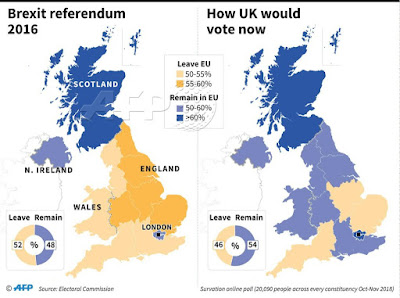 |
| Britain's Prime Minister Theresa May aborted a vote on the deal set for Tuesday because of its certain defeat (AFP Photo/EMMANUEL DUNAND) |
London
(AFP) - The latest Brexit summit in Brussels leaves Theresa May facing a
dwindling number of options over Britain's exit from the EU.
The 27
leaders made abundantly clear to the British prime minister that the draft
withdrawal agreement they reached after nearly two years of talks was not open
to change.
Any
meaningful alterations will come only in a separate treaty on future economic
relations that the sides will begin discussing after Britain leaves the bloc on
March 29.
Here are
the four main scenarios facing Britain while the clock ticks down to the day it
departs the European project after 46 years:
Deal
This is the
Brexit that the British government and EU leaders want -- and one which the
British parliament refuses to accept.
The deal
has been rejected from opposing wings of parliament for either keeping Britain
tied too closely or remotely to the European Union.
Brexit
backers in her party then plotted an ultimately unsuccessful coup that saw more
than a third back a motion to force May out.
May
promised them she would wring concessions from Brussels on Thursday and Friday.
But
exasperated EU leaders told Britain to finally make up its mind about what it
wants.
May's
government intends to reintroduce the very same draft for a vote some time
between January 7 and January 21.
It will
hope that fear of the chaos that a no-deal exit might bring will force
lawmakers to put aside their reservations.
No-deal
This is the
doomsday scenario that threatens to trigger a recession in Britain and markedly
slow the European Union's economic growth.
May's
agreement was meant to keep trade rules between the world's fifth-biggest
economy and largest single market almost unchanged for a transition period
running through the end of 2020.
A sudden
shift to different standards would impact almost every economic sector -- and
possibly see the costs of everyday products in Britain soar.
Both sides
have been forced to ramp up their preparations for a disorderly Brexit over the
past few weeks.
UK
businesses are stockpiling goods while Brussels is trying to find a way to
maintain free-flowing operations involving London's massive financial services
hub.
Second
referendum
Britons
have been mulling another vote on their relationship with Europe since shortly
after the first one backed Leave by a 52-48 margin in June 2016.
There is no
law keeping Britain from doing it all over again.
Yet many
question whether this would be democratic -- and why a second attempt should
take precedence over the first.
It also
threatens to be just as divisive. Opinion polls show the country still split
over whether Brexit is worth it or not.
Proponents
are mostly EU supporters who argue that the Brexit people were promised looks
nothing like the deal the sides have reached.
They add
that Britons never backed a no-deal scenario and should be given the chance to
opt out.
Opponents
say that Britain cannot simply keep voting until people who like the EU get
their way.
It is also
unclear what options to give people in a second ballot -- and what happens if
Brexit wins again.
No Brexit
Britain
appears to have two ways of still staying in the European Union.
The first
would involve a referendum in the which Remain wins.
The second
could see the government decide on its own to revoke Article 50 of the EU
treaty that lays out the process for leaving the union.
Leaders
ranging from EU President Donald Tusk to France's Emmanuel Macron have said in
the past year that Britain would be welcomed back with open arms.
Yet May
shows no signs of changing her mind.













No comments:
Post a Comment
Note: Only a member of this blog may post a comment.